

Reference Materials. Challenging Homophobia: An Educator's Resource.
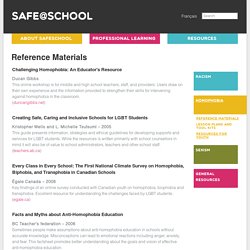
Sources of Strength. CBS Collaborative Teacher Inquiry. A Resource Handbook for Mentors. ConversationStarters. 5 tips to engage students in courageous conversations. 3.
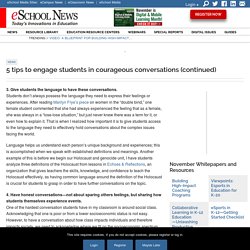
Give students the language to have these conversations. Students don’t always possess the language they need to express their feelings or experiences. After reading Marilyn Frye’s piece on women in the “double bind,” one female student commented that she had always experienced the feeling that as a female, she was always in a “lose-lose situation,” but just never knew there was a term for it, or even how to explain it. That is when I realized how important it is to give students access to the language they need to effectively hold conversations about the complex issues facing the world. Language helps us understand each person’s unique background and experiences; this is accomplished when we speak with established definitions and meanings. Teaching Students with Special Needs. It is inevitable that you will have the opportunity (and pleasure) of working with special needs students in your classroom.
You may need to make accommodations for some and modifications for others. Providing for the needs of special education students will certainly be one of your greatest challenges as a professional educator. Learning Disabilities. Teaching Strategies Learning Disabilities Learning disability is a general term that refers to a heterogeneous group of disorders manifested by significant difficulties in the acquisition and use of listening, speaking, reading, writing, reasoning, or mathematical abilities.
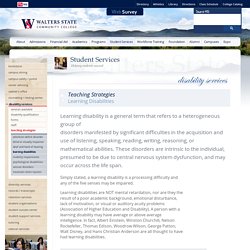
These disorders are intrinsic to the individual, presumed to be due to central nervous system dysfunction, and may occur across the life span. Simply stated, a learning disability is a processing difficulty and any of the five senses may be impaired. Learning disabilities are NOT mental retardation, nor are they the result of a poor academic background, emotional disturbance, lack of motivation, or visual or auditory acuity problems (Association of Higher Education and Disability).
A person with a learning disability may have average or above average intelligence. The Impact learning disabilities have on academic performance No two individuals with a learning disability are alike. Transition Planning for Individuals with Learning Disabilites. What Is Transition?
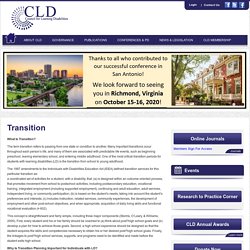
The term transition refers to passing from one state or condition to another. Many important transitions occur throughout each person’s life, and many of them are associated with predictable life events, such as beginning preschool, leaving elementary school, and entering middle adulthood. One of the most critical transition periods for students with learning disabilities (LD) is the transition from school to young adulthood. This concept is straightforward and fairly simple, including three major components (Storms, O’Leary, & Williams, 2000). Transition Resource Guide for Students with Disabilities - Transition to Post-Secondary Education. Manitoba Education and Training. Behaviours of Concern - Education Rights. NEXECE006. k12 safeandcaring handbook parents children exceptionalities.
TransitionPlanfortheIndividualEducationPlan(IEP) Sample NCDSB. Peacemaking Circles. Peacemaking Circles is a process that brings people together who wish to participate in conflict resolution, support, decision making or provide a space to acknowledge responsibility for ones behavior.
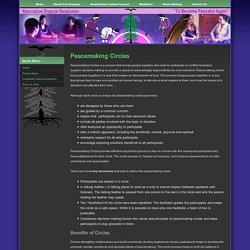
Peacemaking circles bring people together in a way that creates an atmosphere of trust. The process brings people together in a way that allows them to see one another as human beings, to talk about what matters to them, and how the impact of a situation has affected their lives. Although each circle is unique all peacemaking circles generally: are designed by those who use them are guided by a common concern require that participants act on their personal values include all parties involved with the topic or situation offer everyone an opportunity to participate take a holistic approach, including the emotional, mental, physical and spiritual maintains respect for all who participate encourage exploring solutions beneficial to all participants. Defining Restorative. Examples of Accommodations & Modifications.
Program accommodations and modifications are available to children who receive services under IDEA or Section 504 of the Rehabilitation Act.
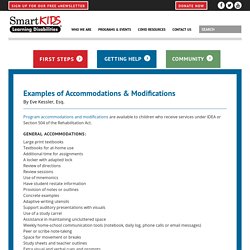
General Accommodations: Testing and Assessment Accommodations: Answers to be dictated Frequent rest breaks Additional time Oral testing Untimed tests Choice of test format (multiple-choice, essay, true-false) Alternate ways to evaluate (projects or oral presentations instead of written tests) Accept short answers Open-book or open-note tests Read test and directions to student Provide study guides prior to tests Highlight key directions Test in alternative site Use of calculator or word processor Extra credit option Pace long-term projects Preview test procedures Simplified test wording; rephrased test questions and/or directions. AUTOMATIC READABILITY CHECKER, a Free Readability Formula Consensus Calculator. Our Automatic Readability Checker takes a sample of your writing and calculates the number of sentences, words, syllables, and characters in your sample.
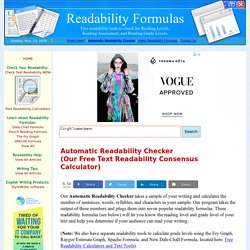
Our program takes the output of these numbers and plugs them into seven popular readability formulas. These readability formulas (see below) will let you know the reading level and grade level of your text and help you determine if your audience can read your writing. (Note: We also have separate readability tools to calculate grade levels using the Fry Graph, Raygor Estimate Graph, Spache Formula, and New Dale-Chall Formula, located here: Free Readability Calculators and Text Tools). Planningentry. Shared. The Positves and Negatives Effects of Labeling Students "Learning Disabled" It is important for teachers to be aware of the possible consequences of the "learning disabled" label.
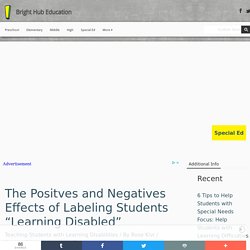
By identifying issues associated with the label, teachers can intercede when negative issues occur. Positive Effects The "learning disabled" label allows educators the opportunity to give extra support to the student. Educators can develop an individualized education plan and offer extra learning support and specialized education to help the student succeed in school. Individualized Education Plan. The Difference Between Accommodations and Modifications. Creative Teaching and Teaching Creativity: How to Foster Creativity in the Classroom — Psych Learning Curve. “Describe the tongue of a woodpecker,” wrote Leonardo Da Vinci on one of his to-do lists, next to sketching cadavers, designing elaborate machines, and stitching costumes.
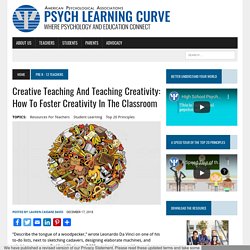
Da Vinci filled over 7,000 notebook pages with questions, doodles, observations, sketches, and calculations. He nurtured creativity as a habit and skill every day—and it paid off. Da Vinci’s work reshaped multiple disciplines, from science, to art, to engineering. I was intrigued when my co-teacher suggested using “Da Vinci” notebooks in our 2nd grade classroom. The idea was simple: students keep notebooks, independent of any academic subject, where they can try creative exercises and explore personal passions. Within a week, the results astounded me. By the end of the year, the Da Vinci notebooks were gloriously full. The Da Vinci notebooks weren’t just for students.
Do your students regularly display and develop their creativity while in your classroom? What is Self-Expression and How to Foster It? (20 Activities + Examples) Do you ever stop to think about how you share yourself with others?
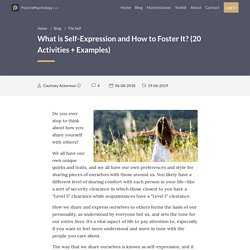
We all have our own unique quirks and traits, and we all have our own preferences and style for sharing pieces of ourselves with those around us. You likely have a different level of sharing comfort with each person in your life—like a sort of security clearance in which those closest to you have a “Level 5” clearance while acquaintances have a “Level 1” clearance. How we share and express ourselves to others forms the basis of our personality, as understood by everyone but us, and sets the tone for our entire lives. It’s a vital aspect of life to pay attention to, especially if you want to feel more understood and more in tune with the people you care about.
The way that we share ourselves is known as self-expression, and it turns out there are a lot of ways to do it. 5ff7e1ff794fa64bcb3e13aa50a4be3e5463. EquityEducationStrategy. Ontario Youth Rainbow Coalition. Every Teacher Project Final Report WEB. ProfAdvSocMediaENPRINT. 119. Safe and Accepting Schools. Skip to content Ontario.ca Français Ministry of Education Home Students Parents Teachers Administrators About the Ministry News. The immigration experience through children's eyes.
Professor of Computer Science; Tier 1 Canada Research Chair in Cybersecurity; director of Canadian Institute for CybersecurityCity: Fredericton, New BrunswickCountry of Origin: Iran Ali Ghorbani came to Canada with his wife, Mahin, and three children, Baharak, Babak and Forough, in 1991 and have called it home ever since. Public Perceptions of an Immigrant Serving Agency in Winnipeg. Changes in the Positivity of Migrant Stereotype Content.
Increasing Newcomers Sense of Belonging. Welcoming Newcomers to Canada: Strategies for Increasing the Warmth of the Welcome and Promoting a Sense of Belonging among Newcomers – Pathways to Prosperity: Canada. Research Team: Danielle Gaucher, University of Winnipeg; Justin Friesen, York University; Jorge Fernandez, Immigrant Centre, Winnipeg; Vicki Sinclair, Immigrant Centre, Winnipeg Institutional Partner: Immigrant Centre, Winnipeg Belongingness — the psychological sense that one fits and is accepted in an environment – is a fundamental human need and is associated with many positive outcomes, such as greater social cohesion, more positive health outcomes, and better academic performance. Our research will include a comprehensive review of the literature on the social-psychological factors that promote belongingness and well-being among newcomers.
This will lead to the development of a fact sheet for the P2P online tool kit that will outline the various factors that increase newcomers’ sense of belonging. A final component of this project will focus on the Immigrant Centre, Winnipeg, and specifically how it is viewed by community members. TASSC - Home. Frontier College - Programs in Indigenous Communities. Indigenous Summer Literacy Camps and The Lieutenant Governor of Ontario’s Indigenous Summer Reading Camps The Indigenous Summer Literacy Camps program began in 2005 – a vision of the former Lieutenant Governor of Ontario, the Hon.
First Nations, Métis and Inuit Curriculum Collection. First Nations Pedagogy Online Best Practices. Catholic schools sow seeds of understanding Indigenous culture. Culturally Relevant Pedagogy in Education for First Nations, Metis, & Inuit Students. First Nations, Métis and Inuit Curriculum Collection. Talking Circles Overview from the First Nations Pedagogy Online Project. PUB LFP POSTER Principles of Learning First Peoples poster. First Nations Pedagogy Online Best Practices. Connecting With Culture for Life. Celebrating Indigenous Peoples in Canada: Learning and activity guide. Participation in extracurricular activities and high school completion among off-reserve First Nations people.
By Paula Arriagada [Release from The Daily] [Full article in PDF] Nutrition.
Prevseriespolicybarr. Defining Restorative. Culturally Responsive Teaching: 16 Ways to Integrate It Into Your Classroom. In today's increasingly diverse schools, culturally responsive teaching is a crucial way to make sure all the students in your classroom get the attention they need and the respect they deserve. Restorative Practice Cultivating Community. Restorative Practice - DDSB. Carbon Footprint Calculator. How to Reduce Your School's Eco-Footprint. This how-to article accompanies the feature "Reading, Writing, Recycling: One Oregon School Is Making the Planet a Better Place. " Rod Shroufe, founder of Clackamas High School's sustainable-systems class, says making your school more eco-friendly is just a matter of taking the initiative.
He offers these tips: Assess your current facility. Module 11: Indigenous knowledge & sustainability. Introduction Sophisticated knowledge of the natural world is not confined to science. Principles of learning. Activities. Classroom Culture. Culture in the Classroom. CBS ResponsivePedagogy. NeedtoKnowSExp. Safe Schools: Reporting and Responding. SaferSchools. The Student Safety Plan. Cyberbullying scenarios 2014. ProfAdvSocMediaENPRINT. Document. Caring Safe School.
Supporting Marginalized Students in Stressful Times: Tips for Educators.